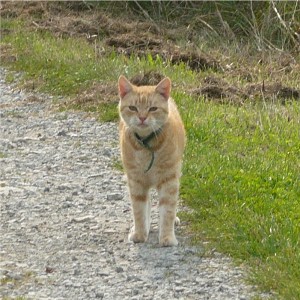
Okay, here’s what I think: more women need to read this book. Looking over the reviews I note that most are from men who have read everything Pynchon has written. I hadn’t read anything by him (no, not even
Gravity's Rainbow) and I thought the time was right for me to begin. He is considered a writer of great stature and I couldn’t remember why I ignored him.
This is a valentine to women. Even the title refers to women, in all its interpretations: The bloody edge of a knife held against the neck of the forces that will subjugate us; the (monthly) bleeding forward edge of an insurgency resistant to control; the bleeding heart of a mother's love for her children and the fury that unleashes itself when they are threatened. This story is about cool (mostly), calculating (sometimes) resistance against the machine. And it is
so funny. I found myself shaking with laughter about three-quarters of the way through. His humor is cumulative. At some point you have to crack a smile, snort at a joke, choke out a guffaw.
I also didn’t know Pynchon was reclusive. My first thought that came to mind when learning this was that he doesn’t like the rest of us very much and can’t stand to interact. But that doesn’t appear to be the case from reading this book. Don’t think for a moment that because
he is not in view,
we are not in view. He is relentless in his observation, prodding and measuring our postures and attitudes. He apes us, “cans” us for future use. Now I know why he insists on anonymity: the better to catch us at our unconscious most. (best?)
But he
likes us. He is gentle with his characters and the characters are
us. Except Gabriel Ice. Pynchon is not nice to Ice, the cold industrialist who will collaborate with the forces of evil to achieve power at any cost to others. There is a thick vein of paranoia pushing the narrative forward: “paranoia’s the garlic in life’s kitchen…you can never have enough.”
Pynchon is described in articles about him as an ”incomparable mimic,” which may be why, reading this latest novel, I thought he was Jewish. The novel in set in New York in 2001 and he has captured the speech patterns, the attitudes, the atmosphere precisely, though perhaps with more wit and humor than we usually enjoy there. This is a man who mines deeply what he encounters in his experience.
The first 85 pages or so may have been deliberately obscure--to keep out day-trippers perhaps--but starting any book is complicated, and this has lots of characters to introduce, including the Deep Web. We all get lost there the first time in. He tells us to hold on: “'It's all right, the dialogue boxes assure her, 'it's part of the experience, part of getting constructively lost.'” After this point, he becomes positively lucid.
He helps us along by including a woman for those of us “whose eyes glaze over” without a woman in the story. In fact, he makes her the lead: Maxine. She is a fraud investigator who’s had her license revoked, leaving her free to use slightly-less-than-perfectly-straight methods to find out about her clients and the objects of their scrutiny. She can also pack a Beretta. (I
told you forensic accounting was hot: check out the
Ava Lee series by Ian Hamilton.)
Maxine is a mother first and last, wife, and skeptic with antennae for a scam. She enjoys a wide circle of dubious contacts on the margins, and has an erotic liaison with an ambiguous hosiery-shredding
King Lud Windust, a government (double?) agent. In the post internet boom of the nineties one firm, hashslingrz, the brainchild of Gabriel Ice, has come on her radar.
This feast of symbols has a larger message that is not too difficult to understand, but mostly it is just a fun ride. Not having encountered Pynchon before gave me an advantage, perhaps. I certainly didn’t think he was more difficult than others I have read, Bolaño for one, Pamuk for another. And he was
a lot funnier. I did find myself wondering who
is this guy?
Little is known of Pynchon the man, but a few souls have attempted to share what they’ve found out, including a
2013 vulture.com article by Boris Kachka: “For much of his life he would flee crowds and cities, dipping a toe into cultures and communities and then leaving and skewering them in turn.”
So this is what I’ve been able to glean about him from reading the book: he watches a lot of movies; he listens to music; he has a wide circle of friends who preserve his deliberate inconspicuousness. He
listens. He
observes. But does he
read? Voraciously. Everything. But does he read novels? Recent novels? I think he does. I trust he does.
I like to think Pynchon has a measure of stability and pleasure in his home life now.
Bleeding Edge doesn’t have the emptiness and alienation I associate with someone who is completely outside the life the rest of us enjoy. He is one of us.
I wish him well. Good vibes, coming your way.
The following writings will help immeasurably with your understanding of the novel. For a writer, Pynchon has a remarkably small body of published work, but he is consistent.
Pynchon on SlothPynchon Review of Love in the Time of Cholera Is it OK to be a Luddite? Thomas Pynchon reviews David Foster Wallace You can buy this book here:



































